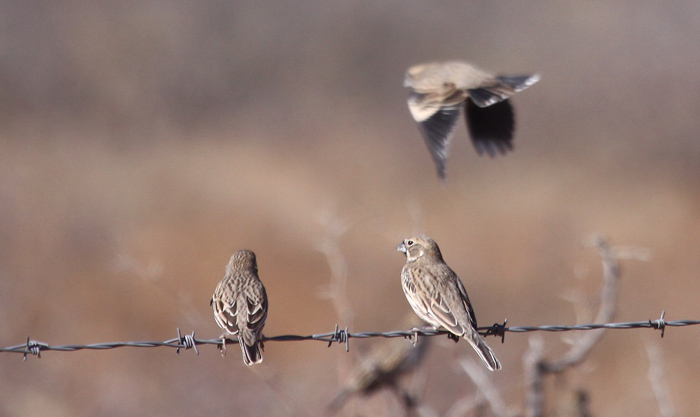Comments:
This month we have 3 birds, 1 in flight and 2 on a fence. If you see
brown, streaky birds sitting on a fence in Utah, you should be
thinking Emberizidae (sparrows, buntings, etc). This group is well
represented in Utah so we have a lot of choices. Other than the
emberizids, Horned Larks are also common fence sitters and may be a
possible answer.
We can answer this quiz by looking at any of the 3 birds, but letís
start with the birds on the fence. Looking at the bird on the right we
can see it has a grayish blue bill and it is fairly large (at least
compared to some other sparrows like a savannah for example). The
color alone eliminates most of the sparrows, but there are a few with
grayish bills. Both sitting birds also have very distinct light/dark
patterns on their primary feathers. When I was looking at these birds
(and more with them) the contrast was very obvious Ė enough so that
when I got home I looked it up in a sparrow book to see if any other
sparrow showed the contrast that strongly. I donít think so, but it
really isnít mentioned very much in the guides. That may because there
are much easier things to look for with this bird and 99% of the time
you wonít see only the backside.
Letís move on to the bird in flight. I think this one should be the
easiest of the three to ID. Black primaries & secondaries with a white
patch flashing on the coverts. The tail is also black, with white tips
on most feathers. These characteristics eliminate every sparrow except
the correct answer. The tail of a Horned Lark is mostly black, but it
is brown down the middle. They also donít have white tips, but a white
outer tail feather. Lark Sparrow has white tipped tail feathers, but
it has a lot more white than this bird, plus the tail and wings arenít
black. The Longspur species all show some amount of black & white
pattern in the tail, but they arenít white tipped. They donít have
black wings either. That leaves us only 1 possibility Ė Lark
Buntings.
Lark Buntings are rare in Utah, but they breed (although not every
year?) in the far NE corner of the state. They can also be seen during
migration, but very rarely. I took this photo south of Wilcox, AZ in
November. I probably saw 5000 throughout the day.
|

